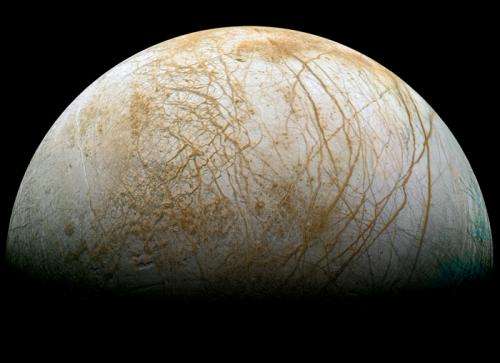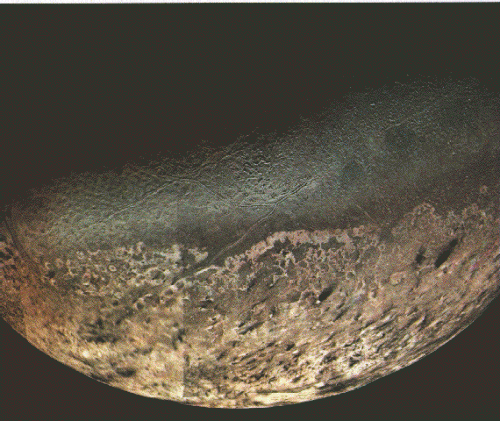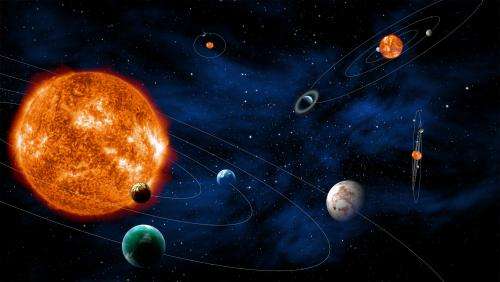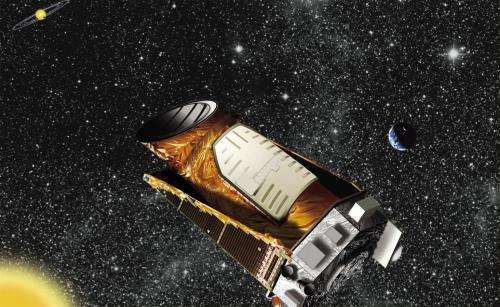Exomoons Could Be Abundant Sources Of Habitability

With about 4,000 planet candidates from the Kepler Space Telescope data to analyze so far, astronomers are busy trying to figure out questions about habitability. What size planet could host life? How far from its star does it need to be? What would its atmosphere need to be made of?
Look at our own solar system, however, and there's a big gap in the information we need. Most of the planets have moons, so surely at least some of the Kepler finds would have them as well. Tracking down these tiny worlds, however, is a challenge.
A new paper in the journal Astrobiology, called "Formation, Habitability, and Detection of Extrasolar Moons," goes over this mostly unexplored field of extrasolar research. The scientists do an extensive literature review of what is supposed about moons beyond the Solar System, and they add intriguing new results.
A wealth of moons exist in our own solar system that could host life. Icy Europa, which is circling Jupiter, was recently discovered to have plumes of water erupting from its surface. Titan, in orbit around Saturn, is the only known moon with an atmosphere, and could have the precursor elements to life in its hydrocarbon seas that are warmed by Saturn's heat. Other candidates for extraterrestrial hosts include Jupiter's moons Callisto and Ganymede, as well as Saturn's satellite Enceladus.
Lead author René Heller, an astrophysicist at the Origins Institute at McMaster University, in Ontario, Canada, said some exomoons could be even better candidates for life than many exoplanets.
"Moons have separate energy sources," he said. "While the habitability of terrestrial planets is mostly determined by stellar illumination, moons also receive reflected stellar light from the planet as well as thermal emission from the planet itself."
Moreover, a planet like Jupiter—which hosts most of the moons in the Solar System that could support life—provides even more potential energy sources, he added. The planet is still shrinking and thereby converts gravitational energy into heat, so that it actually emits more light than it receives from the Sun, providing yet more illumination. Besides that, moons orbiting close to a gas giant are flexed by the planet's gravity, providing potential tidal heating as an internal, geological heat source.
Finding the first exomoon
The first challenge in studying exomoons outside our Solar System is to actually find one. Earlier this year, NASA-funded researchers reported the possible discovery of such a moon, but this claim was ambiguous and can never be confirmed. That's because it appeared as a one-time event, when one star passed in front of another, acting as a sort of gravitational lens that amplified the background star. Two objects popped out in the gravitational lens in the foreground—either a planet and a star, or a planet and an extremely heavy exomoon.
For his part, Heller is convinced that exomoons are lurking in the Kepler data, but they have not been discovered yet. Only one project right now is dedicated to searching for exomoons, and is led by David Kipping at the Canadian Space Agency. His group has published several papers investigating 20 Kepler planets and candidates in total. The big restriction to their efforts is computational power, as their simulations require supercomputers.

Another limiting factor is the number of observatories that can search for exomoons. To detect them, at least a handful of transits of the planet-moon system across their common host star would be required to absolutely make sure that the companion is a moon, Heller said. Also, the planet with the moon would have to be fairly far from its star, and decidedly not those close-in hot Jupiters that take only a few days to make an orbit. In that zone, the gravitational drag of the star would fatally perturb any moon's orbit.
Heller estimates that a telescope would need to stare constantly at the same patch of sky for several hundred days, minimum, to pick up an exomoon. Kepler fulfilled that obligation in spades with its four years of data gazing at the same spot in the sky, but astronomers will have to wait again for that opportunity.
Because two of Kepler's gyroscopes (pointing devices) have failed, Kepler's new mission will use the pressure of the Sun to keep it steady. But it can only now point to the same region of the sky for about 80 days at at time because the telescope will periodically need to be moved so as not to risk placing its optics too close to the Sun.
NASA's forthcoming Transiting Exoplanet Survey Satellite is only expected to look at a given field for 70 days. Further into the future, the European Space Agency's PLAnetary Transits and Oscillations of stars (PLATO) will launch in 2024 for what is a planned six-year mission looking at several spots in the sky.
"PLATO is the next step, with a comparable accuracy to Kepler but a much larger field of view and hopefully a longer field of view coverage," Heller said.
Clues in our solar system
Heller characterizes moons as an under-appreciated feature of extrasolar planetary systems. Just by looking around us in the Solar System, he says, astronomers have been able to make crucial explanations about how the moons must have formed and evolved together with their planets. Moons thus carry information about the substructure of planet evolution, which is not accessible by planet observations alone.
The Earth's moon, for example, was likely formed when a Mars-sized object collided with the proto-Earth and produced a debris disk. Over time, that debris coalesced into our moon.

While Heller says the literature mostly focuses on collision scenarios between an Earth-sized object and a Mars-sized object, he doesn't see any reason why crashes on a bigger scale might not happen. Perhaps an Earth-sized object crashed into an object that was five times the mass of Earth, producing an extrasolar Earth-Earth binary planet system, he suggests.
Another collision scenario likely took place at Uranus. The gas giant's rotation is tilted about 90 degrees in its orbit around the Sun. In other words, it is rolling on its side. More intriguing, its two dozen moons follow Uranus' rotational equator, and they do not orbit in the same plane as Uranus' track around the Sun. This scenario suggests that Uranus was hit multiple times by huge objects instead of just once, Heller said.
Examining mighty Jupiter's moons gives astronomers a sense of how high temperatures were in the disk that formed the gas giant and its satellites, Heller added. Ganymede, for example, is an icy moon. Models indicate that beyond Ganymede's orbit (at about 15 Jupiter radii) it is sufficiently cold for water to pass from the gas to the solid (ice) stage, so the regular moons in these regions are very water-rich compared to the inner, mostly rocky moons Io and Europa.
"It sounds a bit technical, but we couldn't have this information about planetary accretion if we did not have the moons today to observe," Heller said.

Some moons could also have been captured, such as Neptune's large moon, Triton. The moon orbits in a direction opposite to other moons in Neptune's system (and in fact, opposite to the direction of other large moons in the Solar System.) Plus, its odd terrain suggests that it used to be a free-floating object that was captured by Neptune's gravity. Neptune is so huge that it raised tides within the moon, reforming its surface.
Even comparing the different types of moons around planets in the Solar System reveals different timescales of formation. Jupiter includes four moons similar in size to Earth's moon (Europa, Callisto, Ganymede and Io), while the next largest planet in our solar system, Saturn, only has one large moon called Titan. Astronomers believe Saturn has only one large moon because the gas that formed objects in our solar system was more plentiful in Jupiter's system to provide material for the moons to form.
The gas abundance happened as a consequence of the huge gas giant creating a void in the material surrounding our young Sun, pulling the material in for its moons. Saturn was not quite large enough to do this, resulting in fewer large moons.
More strange situations could exist beyond our solar system's boundaries, but it will take a dedicated search to find exomoons. Once they are discovered, however, they will allow planet formation and evolution studies on a completely new level.
Journal information: Astrobiology
Source: Astrobio.net
This story is republished courtesy of NASA's Astrobiology Magazine. Explore the Earth and beyond at www.astrobio.net .










.jpg)







